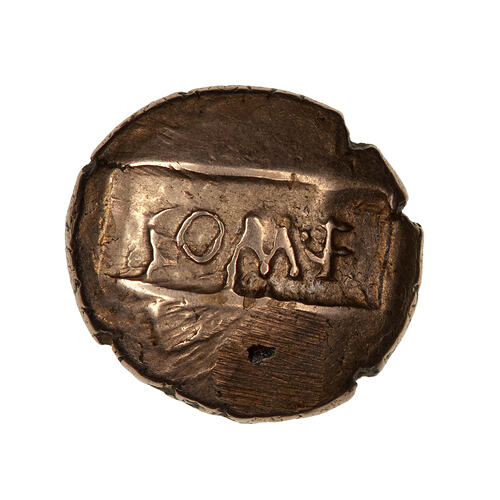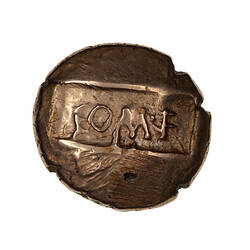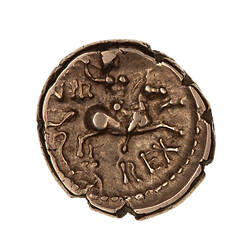Summary
Gold coin; Denomination Stater
Issued by King Verica of the Atrebates Tribe
Verica was the last King of the Atrebates. The coin has Latin legends reflecting their role as a Roman Client Kingdom. The obverse states that Verica is the son of Commius and the reverse that he is the King.
Obverse Description
On sunken tablet, COM.F (translation, son of Commius)
Reverse Description
Horseman galloping right brandishing spear; above, VIR ; below, REX ; behind and below a curved ornament (Gallic chariot?)
Edge Description
plain
Significance
In Gaul the Atrebates lived roughly in the area known today as Artois (derived from the tribal name) in Northern France. When Julius Caesar began his conquest of the area they committed men to a regional alliances but were unable to defend themselves. Caesar established or recognised Commius as their King and he was involved, on the Roman side, in Caesar's two invasions of Britain (55 and 54 BC). However, Commius later joined the revolt of Vercingetorix against the Romans and ended up taking refuge in Britain with many of his tribe members.
In Britain the Atrebates settled in an area around modern Hampshire, Surrey and western Sussex, which had earlier links with migration or invasion from Gaul. Under the influence of Commius they soon came to rule this area. The first Roman Emperor, Augustus recorded two British Kings presenting themselves to him one of these is believed to have been Tincommius a brother of Verica, the lands of the Atrebates were recognised by the Romans as a client kingdom. Tincommius and his two brothers, Eppillus and Verica, who ruled after him, both issued coins bearing their names.
A bordering tribe, the Catuvellauni under their chief Cunnobuline and later his son Caratacus eventually conquered the lands of the Atrebates. Verica fled to Rome and gave the Roman Emperor Claudius a pretext for his invasion and conquest of Britain in AD 43.
More Information
-
Collecting Areas
-
Acquisition Information
Transfer from National Gallery of Victoria (NGV), 15 Mar 1976
-
Acknowledgement
Purchased, Felton Bequest, 1929
-
Date Issued
10-40 AD
-
Issued By
King Verica - Atrebates Tribe, Atrebates, Ancient Britain, 10-40 AD
-
Denomination
-
Series
-
Material
Gold
-
Axis
3
-
Classification
-
Category
-
Discipline
-
Type of item
-
Dimensions
17 mm (Outside Diameter), 5.3 g (Weight)
-
Shape
Round
-
References
Mack 121 Evans II.10
[Book] Mack, R. P. 1975. The Coinage of Ancient Britain.
[Book] Evans, John. 1864. The Coins of the Ancient Britons.
-
Keywords


